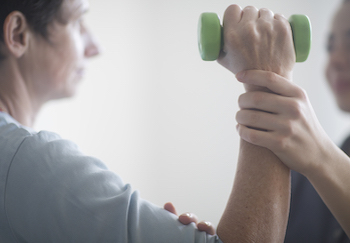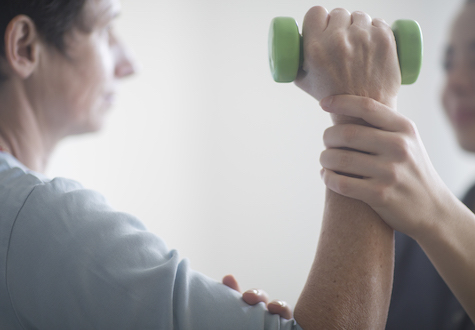
A stroke can happen to anyone, at any time. Stroke is the leading cause of serious disability in the United States. This condition can also lead to lasting brain damage, paralysis, trouble thinking, talking and swallowing.
If you or someone you love has had a stroke, you’re probably wondering, now what? Will a stroke recovery process give you your life back? A lot of your post-stroke therapy is dependent on the location and severity of the stroke.
The Odds of Stroke Recovery: In Your Favor?
According to the National Stroke Association:
- 10% of stroke survivors recover almost completely
- 25% recover with minor deficits
- 40% have moderate to severe issues requiring assistance
- 10% need more attentive care in a nursing home or long-term care facility
- 1% die shortly after a stroke
Your odds of recovering after a stroke increase with the proper recovery process. This includes a team of therapists, caregivers, and you, the patient, working hard for success.
What Is A Stroke?
A stroke is when the blood supply to part of the brain is blocked or a blood vessel burst.
Physical Therapy After Stroke
A physical therapist (PT) is a movement expert who helps patients reach their goals through physical exercise and hands-on care. Chad Aldridge, a physical therapist at UVA, works with patients in the neurology and neurosurgery department. He has years of experience with stroke patients and sees the importance of physical therapy during recovery.
Physical therapy helps patients during the stroke recovery process in multiple ways. After a stroke, patients may experience difficulty moving and getting around. They might have balance issues and weak muscles when standing or participating in other activities. Aldridge says that physical therapists “tailor their therapy to the patient.”
Evaluation & Exercise Before You Leave the Hospital
The first step for the physical therapist after a stroke patient has been stabilized is to perform a quick evaluation to determine the patient’s movement level and potential fall risk. Finding the right exercise for the individual is essential. The goal of physical therapy at this point is to get the patient’s strength and independence back before being discharged.
Aldridge focuses on the body as a moving system. He uses everyday life activities for exercises, like getting out of bed and using mirrors as visual feedback. He also uses balloons, getting patients moving as they play catch.
Prepping to Go Home
Aldridge encourages caregivers to work with their loved ones at the hospital and at home. A patient recovering from a stroke may find the first couple nights back home hard. Aldridge recommends talking with your providers about available resources to help at home, so caregivers aren’t getting overwhelmed as well. The journey may not end at home, as a stroke patient might need outpatient therapy after leaving the hospital.
Occupational Therapy for Stroke Recovery
An occupational therapist (OT) helps patients achieve their daily routine goals through therapeutic activities. You may hear the term “functional therapist” when it comes to OT, because function is what they’ll focus on. Erica Umback, a UVA acute care occupational therapist, focuses on her patients’ progress with “the activities they need to be able to do and want to be able to do.”
It’s hard to understand the difficulty for a stroke patient when daily activities are no longer comfortable. Eating, drinking, dressing, bathing, reading and writing are all things we’ve been doing since we were young. After a stroke, a patient may not be able to handle these activities alone while recovering.
An occupational therapist will help stroke patients learn ways to manage their daily activities and regain as much independence as possible. And Umback says she tries to make activities fun or relatable so OT sessions feel more tolerable and motivating. The activities and exercises she chooses for her patients depend on what challenges and goals they have post-stroke.
Getting Back on Track
OT looks at the entire person’s well-being and health during the stroke recovery process. Over the years of her career, Umback has witnessed some patients get frustrated with OT. Because activities that were once easy are difficult now, she sees that part of this therapy addresses psychological health, too. With OT’s holistic focus, psychological health is also addressed. Therapists help patients and families implement positive coping strategies and work toward overall emotional well-being.
The exercises Umback chooses for her patients depends on the problems they have post-stroke. When patients have fine motor coordination limitations, Umback will use specific functional exercises. Examples include lacing shoelaces, typing, stacking coins, writing, and fastening and unfastening buttons.
Speech Therapy After a Stroke
A speech-language pathologist (SLP) works with stroke patients on improving communication and swallowing problems. Communication disabilities – like the ability to speak — depend on which side of the brain the stroke occurred. A stroke on the left side of the brain will affect communication, whereas a stroke on the brain’s right side affects attention, memory and problem-solving skills.
After a stroke, an SLP will visit your room and give you a swallow test. This test determines if you can receive oral medications and eat well. Other screenings will follow to help the SLP understand which of your functions have been impaired, as preparation for the rehabilitation process.
“Without language, a person has minimal ability to communicate with the world,” says Julie Pitti, a UVA speech pathologist. An SLP strategically works with patients to relearn language skills (talking, reading or writing) and help with swallowing problems.
Survivor Support Groups
Trying to get back to your normal routine after a stroke? UVA offers support services and groups for survivors. Share and listen to other experiences while recovering at one of our neuroscience support meetings.
The Right Tools to Speak Again
Pitti explains that a severe inability to speak can frustrate patients. She finds that visual aids can sometimes help when patients have difficulty communicating. When patients are unable to write, having pictures to point to can be effective. Sometimes using apps or a tablet have been found to be helpful at home or with family members.
Pitti also educates caregivers. She recommends the families needs to be supportive when asking question. Give survivors plenty of time to respond while encourages them to be patient during the stroke recovery process. Patients and family members often become frustrated with impaired language and disrupted communication, which can complicate recovery.
